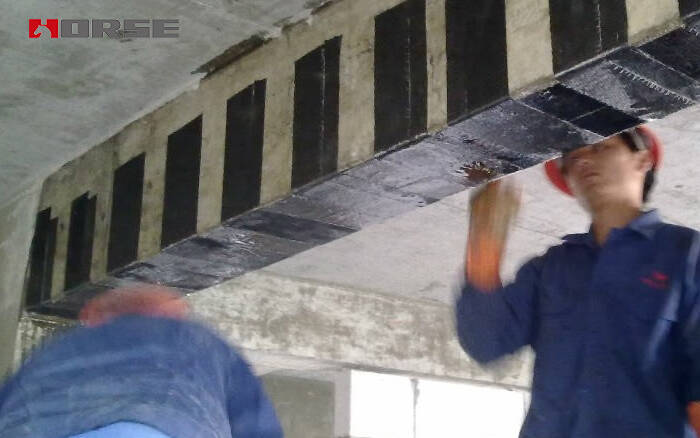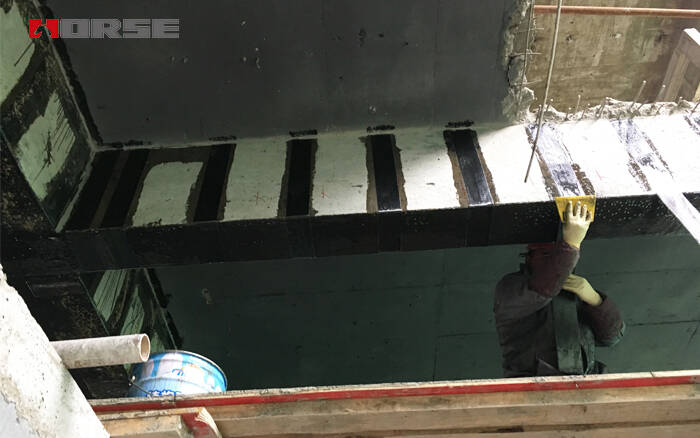Solutions
Horse Construction offers full range of structural strengthening materials with technical supports, documentation supports, products supports, project supports.
CFRP Reinforced Concrete Bearn Fracture Types

CFRP reinforced beams have two main types of failure when they are subjected to bending loads: traditional beam failure and early failure.
The failures of traditional beams are carbon fiber fracture after the steel bar yields and concrete crushing after the steel bar yields.
Early damage is:
① Shear failure of oblique section of concrete beam;
②The stress at the end of the CFRP sheet is concentrated, and the CFRP sheet is debonded;
③The glue layer at the bonding interface between CFRP and concrete is destroyed;
④The concrete protective layer is stripped longitudinally at the height of the longitudinal bars;
⑤CFRP starts to debond from the base of the diagonal shear crack of the concrete beam
The failure of traditional beams
The failure of traditional beams refers to the failure of the reinforced beam with only the normal section, including the tensile failure of the reinforced CFRP sheet or the crushing failure of the pressure zone concrete. These two types of damage are extended damage. Although carbon fiber is a linear elastic material, it has a greater suddenness at the moment of failure, but the failure occurs after a long deformation process after the tensile steel bar yields, so the CFRP tensile failure is still a ductile failure.
Early destruction
Early failure refers to the partial failure of the beam before the traditional failure after reinforcement, resulting in the failure of the reinforced beam to continue working and the expected value of the ultimate flexural bearing capacity of the normal section. The early failure is brittle failure, including two failure forms of concrete beam shear failure and peeling failure.
1 Shear failure
Shear failure refers to the shear failure of concrete beams due to the increase in flexural bearing capacity of the beam after reinforcement, and the lack of shear bearing capacity of the diagonal section. The shear resistance of a concrete beam not only considers the shear force borne by the concrete, but also includes the shear force borne by the aggregate bite and the shear force borne by the pin and bolt of the longitudinal tensile steel bar. In this way, the contribution of CFRP pasted on the tensioned surface to the shear force is relatively limited. The impact of the CFRP sheet against the shear force can be ignored in the design, and the standard can still be used to calculate the shear capacity of the overall beam.
The shear resistance of the original concrete beam becomes the key to the occurrence of shear failure. When performing bending reinforcement, it is necessary to consider whether the shear capacity of the beam can reach the required nominal shear force.
If the nominal shear stress is less than or equal to the shear resistance of the concrete beam, it means that the concrete beam will not undergo shear failure. If it does not meet the requirements, in order to make the ductile failure occur before the brittle failure, and to give full play to the full bending capacity of the concrete beam, it is necessary to perform bending reinforcement at the same time as shear reinforcement.

2 Stripping failure form
Among the early failures, peeling failure is the main failure mode, which can be divided into the following forms:
2.1 Stress concentration at the end of CFRP sheet
The CFRP patch and concrete transfer shear stress and bonding normal stress through the adhesive layer to achieve the purpose of working together. Stress concentration occurs at the end of the reinforcing sheet due to deformation changes, which can generate larger shear stress (anchor shear stress) and normal stress (peel normal stress). When the stress exceeds the strength of the concrete or reaches the shear strength of the glue layer, the concrete beam is often damaged due to local damage and overall damage. This failure mode is complicated and difficult to accurately consider, but it affects the safe use of concrete after reinforcement.
2.2 Destruction of the glue layer at the interface
The carbon fiber sheet and the concrete base layer are bonded together by a binder, forming an interface between the two, and the bond failure is usually at this interface. Generally, the cohesive failure of the glue layer and the adhesion failure of the glue layer and the cemented material are collectively referred to as glue layer failure. When the maximum shear stress of the cemented joint reaches the shear strength of the cement, the adhesive layer will be destroyed and degumming and delamination will occur.
2.3 The peeling failure of concrete protective layer
When the concrete under the main longitudinal tensile steel bar reaches the tensile strength, cracks are formed between the concrete and the steel bar, causing the concrete protective layer to peel off from the steel bar. The concrete protective layer forms a comb-shaped tooth block in the shear span area. It can be assumed that the tooth block is a cantilever beam with shear flow stress acting on its free end. This shear flow stress is also the stress acting on the interface between the external glued board and the concrete. The maximum normal stress in the plate is located at the maximum bending moment, at the end of the shear span away from the plate end. Shear flow stress causes cracks at the fixed end of the cantilever beam. Since the fixed end is located below the main longitudinal tensile steel bar, the appearance of this horizontal crack will inevitably cause the concrete protective layer to peel off from the steel bar.
2.4 CFRP peeling failure at the base of shear crack
After a shear crack appears in the concrete, the concrete on both sides of the crack produces an unequal relative vertical displacement. The crack slides horizontally along the concrete surface and penetrates the bonding layer. Since the interface between the bonding layer and the composite material sheet has been destroyed, the beam fails at this time. The bond between the CFRP sheet and the concrete is sensitive to any cracks in the shear span. Due to the presence of bending and shear cracks in the concrete, the longitudinal steel bars and CFRP produce pin bolts, which causes the beam to produce longitudinal and vertical displacement at the crack position. When the shear resistance of the concrete beam is insufficient, and the diagonal shear cracks develop too fast and too large, the concrete beam will undergo shear displacement up and down. The stress at both ends of the crack is highly concentrated, and peeling cracks occur at the interface between the CFRP sheet and the concrete. The CFRP sheet is debonded from the critical shear crack, and the peeling crack expands along the bonding interface to the end of the slab, which eventually leads to the separation of the CFRP sheet and the concrete beam
At present, the research on this form of damage is limited, and several possible influencing factors:
1) Concrete strength: Concrete strength is the main factor. The high-strength concrete releases a large amount of energy when cracks occur, which makes the bonded slab beams have higher brittleness and is prone to such brittle failure.
2) Reinforcement ratio: The change in the number of longitudinal steel bars and stirrups has no significant effect on the debonding phenomenon of the CFRP board.
3) External anchoring: When the U-shaped anchoring steel plate is bonded to the end of the plate, it can prevent the vertical displacement of the CFRP plate, but cannot prevent the horizontal slip.
The form of CFRP peeling failure generally occurs when the beam is about to reach the ultimate load. The failure is sudden and brittle, and most of the bearing capacity will be lost in an instant, so try to avoid such damage. In order to strengthen the resistance of CFRP to debonding and slippage, the following measures can be taken to improve the structural performance of the beam:
① Increase end anchorage;
② Paste the anchor plate on the side of the shear span area;
③ Add lateral restraint to the concrete in the press area.
You can find anything here you are in need of, have a trust trying on these products, you will find the big difference after that.

High strength, unidirectional carbon fiber wrap pre-saturated to form a carbon fiber reinforced polymer (CFRP) wrap used to strengthen structural concrete elements.

High strength, unidirectional carbon fiber fabric pre-saturated to form a carbon fiber reinforced polymer (CFRP) fabric used to strengthen structural concrete elements.

High strength, unidirectional carbon fiber sheet pre-saturated to form a carbon fiber reinforced polymer (CFRP) sheet used to strengthen structural concrete elements.